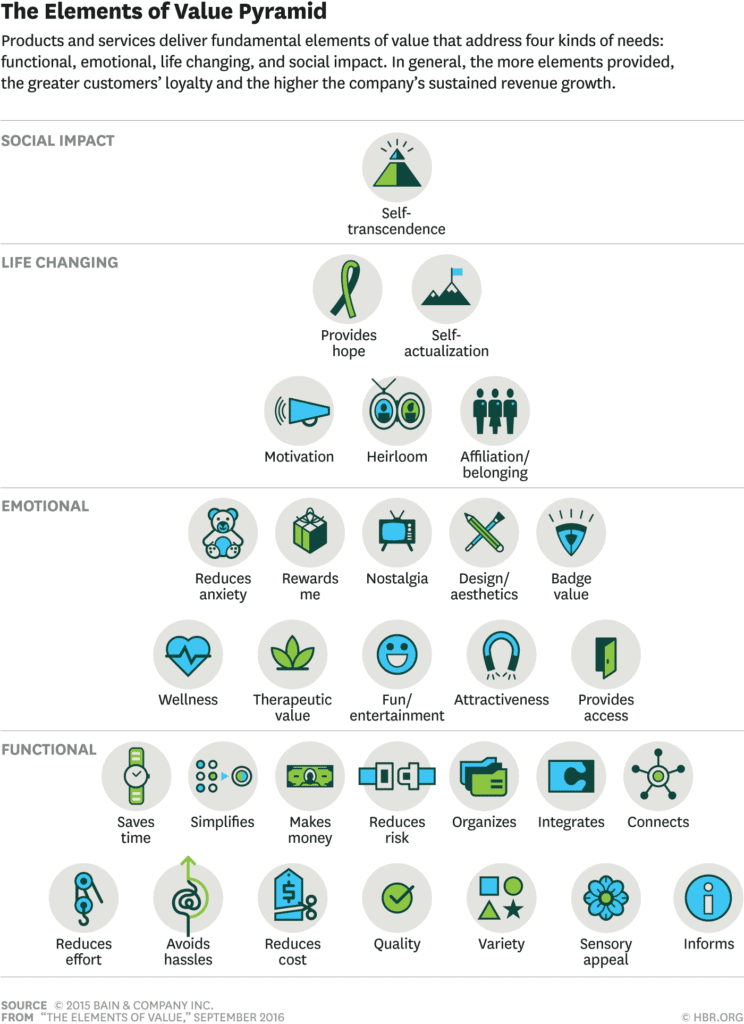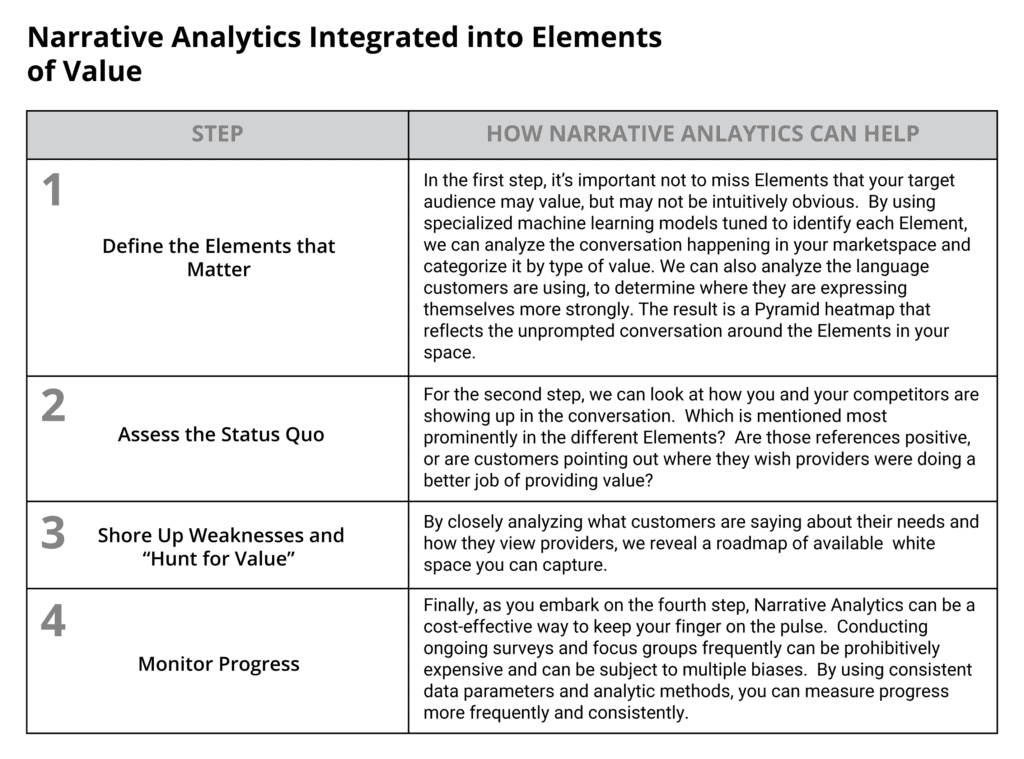One of the most important goals for any marketer–or any company for that matter–is to understand customer needs well. Through detailed and comprehensive insight into the drivers of customer behavior, we can build better products, create more attractive brands, devise messaging that creates connections, and establish ongoing relationships that delight. The question, of course, is how to gain these insights.
In this post we’ll explore how marketers use a relatively new framework for understanding customers needs–the Elements of Value Pyramid–and how that framework can be extended with Narrative Analytics.
Described in this seminal Harvard Business Review article, the Elements of Value Pyramid was created by Bain & Company, based on extensive research and correlation to business performance.
Overview of the Elements of Value Pyramid
There are several key ideas embedded in the framework.
A Defined Set of Specific Values
The first key idea is that the categories of consumer needs are not infinite. Through extensive research and analysis (including correlations to NPS scores and revenue growth), Bain identified just 30 Elements that matter, which are outlined in the diagram below.

The Values Hierarchy
The second key idea is that not all of the Elements are equal. Inspired by Abraham Maslow’s “hierarchy of needs,” Bain categorized the 30 Elements into 4 categories: Functional, Emotional, Life Changing and Social Impact. To some degree, the more foundational Functional Elements enable companies to provide “higher” order Elements. Bain emphasizes, for instance, that a baseline level of Quality is very often necessary before other Elements like Attractiveness or Motivation can come into play.
Different Elements for Different Situations
But that hierarchical relationship isn’t true in every case, and that’s the framework’s third key idea: that context determines which Elements matter. A company in one industry serving one customer segment may have a different set of important Elements than other companies serving other segments. Understanding how the Elements apply in your specific situation is key to deriving value from the framework.
More is Better
The final key idea Bain discovered through its research with the framework is that, by and large, companies that perform well with more Elements are more successful than companies in the same industry that perform well with fewer Elements. As a general rule, addressing more Elements is better. Bain used revenue growth and NPS scores as the measures of success, and both were correlated to strong performance in a greater number of Elements.
Putting the Elements of Value Pyramid into Practice
Bain outlines a process for companies to use the framework to understand customer needs, expand areas of value provision, increase customer satisfaction and grow revenues. Regardless of the industry, the steps are the same.
1. Determine the Elements that Matter
Different products and services naturally lend themselves to different Elements of Value. For instance, Sensory Appeal and Therapeutic Value are more important for Food & Beverage, while Connects and Organizes are more important for Smartphones.
2. Assess the Status Quo
Once the important Elements are defined, the next step is to determine how successfully your company is providing those Elements, and how that compares to your competitors.
3. Shore Up Weaknesses and “Hunt for Value”
If there are significant shortcomings in any of the key Elements for your industry, it’s probably best to start by improving in those areas. Once a solid foundation is established, the task becomes to “hunt for value”–determining where else within the Pyramid you can satisfy a customer need. With a strategy defined, you can implement the steps necessary–product enhancement, branding, marketing–to capture those areas of value.
4. Monitor Progress
Of course, measuring how well your efforts are achieving these goals is critical. Are customers perceiving stronger value provision in the core Elements that matter for your industry, and are they perceiving additional value from the Elements into which you’re trying to expand?
Answering these questions creates an important feedback loop to guide the adjustment of strategies and tactics.
Using Narrative Analytics with the Elements of Value Pyramid
Narrative Analytics can be an important tool in every step of the process outlined above. Protagonist provides a unique window into customers’ perceptions of value through our ability to find the unprompted conversations your customers are having, categorize those conversations with machine learning, analyze customer expressions using specialized NLP tools and summarize key insights to guide your actions.
The following table summarizes how to use Narrative Analytics as you implement the Elements of Value process:

Target Audience Segments and the Pyramid
Through our Audience Analytics offering, we’ve also discovered that the Elements of Value Pyramid can be utilized in other very interesting ways.
With Audience Analytics, we start with the target segment first. Instead of identifying the Elements that matter from the perspective of an industry or product area, we define the Elements that matter from the conversation a target segment is having.
For instance, one client engagement focused on the Young Professionals segment. In addition to surfacing the Narratives the target audience has (such as “Impostor Syndrome”), we can also use our machine learning capabilities to reveal the Elements they care about. For instance, how important is the Time Saving Element in the lives of Young Professionals? How about Elements like Wellness, or Affiliation & Belonging?
Answering these questions reveals a compelling–and actionable–portrait of your target segment. Holding up those organically determined, baseline audience Elements to the industry-determined Elements reveals a roadmap for how your industry–and your company–can better meet the needs of target segments.
For more thoughts on how you can use the Elements of Value Pyramid in conjunction with Protagonist’s capabilities, feel free to schedule a conversation.


